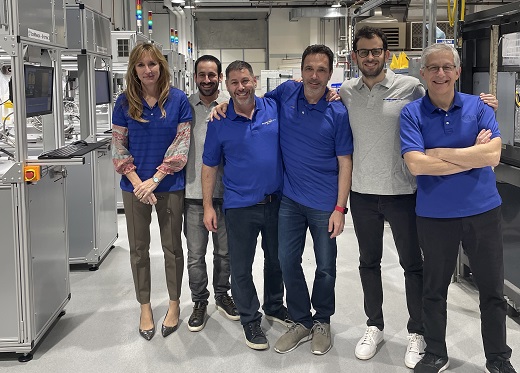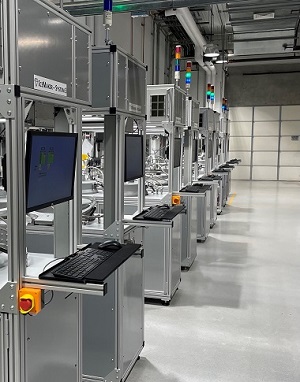|
|
Growth Factor: Interview with Plasmability
The Texas-based producer of lab-created diamonds explains its new supply deal with HRA Group.
Aug 9, 2022 3:49 AM
By Joshua Freedman
|
|
|

RAPAPORT... Long-term supply deals for lab-grown diamonds are coming in thick and fast. Trade buyers want to lock in the best goods, and only a limited number of producers can grow high-quality material, as industry consultant Marty Hurwitz told Rapaport Magazine earlier this year.
“There are more and more players globally, what I would call the scalable customers — the people who need consistent quality and consistent volume every month — who are increasing [in number],” Hurwitz, CEO of MVI Marketing, said in a May interview. “They have to have assurances of consistent supply month over month. As a result, those buyers are establishing long-term relationships with…prime growers that can deliver their product month over month in the range of 500 to 1,000 to 2,000 stones per month.”
Most of these pacts remain secret. However, last week, Texas-based Plasmability announced a partnership with HRA Group, a Canadian diamond manufacturer and former De Beers sightholder. (Hurwitz was involved in introducing the two companies to each other.) The stones will appear on the market under Plasmability’s consumer brand, Clarity Diamond.
Plasmability creates lab-grown diamonds using the chemical vapor deposition (CVD) method at its factory in Austin, Texas. It claims to have an especially efficient process for growing high-quality rough, and has benefited from techniques it borrowed from the semiconductor industry, which was previously the company’s main business. Having switched focus to diamond synthesis, Plasmability specializes in large, high-quality rough. Under the new deal, HRA will be the only company allowed to cut and polish Plasmability’s material and distribute the finished product.
Among Plasmability’s assertions is that its rough is “single growth,” meaning production happens without any pauses. Other companies remove the item from the growth chamber occasionally, reducing the final quality, its executives say. One of the ways it does this is by maintaining a stable temperature during the growth period.
Rapaport News had the opportunity to speak to Bill Holber, Plasmability’s president and chief technology officer, as well as to Bob Basnett, its CEO.
What’s the history of your company?
Holber: We formed Plasmability in about 2010. It was an offshoot of another company that Bob [Basnett] and [his wife] Sherri have had for many years called Semiconductor Support Services. Our original goal was as an incubator of new technologies serving that other company. We created a number of products for that company. Starting a few years ago, we decided to look at other markets. We had some familiarity with the CVD diamond market for historical reasons, and we looked at it pretty carefully and thought about what value we might bring to it. We decided to embark on that market, and we started with an R&D [research and development] effort and slowly grew it over time. We emphasize single-growth material. We start a run and we never interrupt it until the run is done, which tends to leave material of extremely high quality because there are no growth lines in it. Right now, we are focusing on the market for larger, premium goods. Typically, our material is in the range of 2.5 to 4 or 5 carats [in the polished], occasionally 6 carats. And we’re working to extend that to larger sizes.
What sizes are the rough stones that come out of your machines?
Holber: Typically, it averages about 10 carats on the rough. We are working to [increase] that. We’ve done some 15- and 18-carat roughs also. Again, [it’s] single-growth. We don’t do any HPHT [High Pressure-High Temperature] post treatment. We have developed a process that doesn’t require that, which significantly shortens the supply chain and takes complexity out of the process.
When did you start producing for the gem-quality diamond industry?
Basnett: The first really high-quality stone that we produced would have been about 18 months ago. That was the first D- or E-color stone that we got.
What sort of volumes had you been supplying to the jewelry industry before the HRA announcement?
Basnett: Not a whole lot. We’ve had [production of] a couple of thousand carats [of rough] a month. HRA has really taken us to the next level in terms of the ability to not just manufacture the goods but distribute them into the market. Before that, we used some local sales channels that we have here in Texas to help us distribute the material. But we kind of overwhelmed them. And we needed to look at different ways to distribute the product at higher volume levels.
Why is the lack of growth lines so significant?
Basnett: Normally, when people grow this kind of material, they put a seed into the reactor and they grow [a diamond] for a number of hours. After a certain amount of time, they start to develop polycrystalline material or some defects around the edge of the seed. When you’re done, [you get] a cube[-shaped] rough, but it’s really like a layer cake with multiple growth steps in there. The better manufacturers are really good at “hiding” that line, if you will. Every time you have to start and stop the reactor, it can take a long time, because typically you have to open it up, pull the material out, clean the reactor, reset it and get it going again. So it definitely improves the cycle time, all other things being equal. [Also,] every time we have to start or stop the reactor, open it up, clean it, put the material back in, you have the possibility of introducing defects at that interface.
Gemological laboratories occasionally publish reports on lab-grown diamonds that were submitted to them incorrectly as natural. One of the ways they detect this is that the stone has indications of stop-start growth. Is your product harder to detect?
Basnett: In that particular way to detect it, certainly that would make it more difficult. But there are detectors out there that use different techniques...that don’t have anything to do with growth lines. Our material is definitely detectable [with] modern CVD diamond detectors.
What are your production plans?
Basnett: Well, it’s ramping [up] right now. As I mentioned, we’re over a couple of thousand carats a month, and we’re working to introduce some process improvements that will potentially improve our reactors’ output by nearly double. The efficiency of our process is significantly higher than it would have been just a couple of months ago. So for the same power, the same gas, the same personnel, we just get a lot more out of the reactor.
Was it important for you to be supplying to a manufacturer in Canada rather than, for example, in India?
Holber: We were working with a cutter in India. We had a very good relationship. There were no issues. The quality of the material was high. However, it wasn’t a full-service house from the selling standpoint. For us, it worked out better to work with somebody that...had that experience in [both] cutting and selling that we didn’t have.
How does your environmental impact compare with the average for the lab-grown market?
Holber: In Austin, the power we use is close to 50% carbon-free, mostly wind, some solar, a little bit of hydro[electric]. So it’s not 100% — that’s a longer-term issue for us.
How big is your diamond business compared with the rest of your business?
Holber: At this point, it’s 80% or 90%. The [semiconductor] business is a bit of a legacy, and it helped us bootstrap the business. It’s a relatively minor part of our activity at this point. The gem business is our business.
What about gem-quality diamonds versus industrial and technical applications of diamonds?
Holber: We’ve looked a bit at the industrial market. It’s an interesting market. We think there is growth potential, but it’s relatively fragmented in the high-end, electronic-material [segment]. We had, several years ago, an SBIR [Small Business Innovation Research] grant [as part of] a program that the federal government had for many years to support small businesses. We worked with one of the government laboratories on electronic-materials applications. It was a great collaboration. We learned a lot. We think we delivered a lot and it helped fund our initial effort in terms of really learning the core technologies. That kind of material has a market, but for us it’s too fragmented to go after right now. If you’re asking where that market will be in five or 10 years, it might be a very attractive market. And we continue to look at it and field questions from people. But for now, essentially all our effort is on the gem side.
Why did you choose an exclusive deal like this rather than leaving yourself open to supplying to different manufacturers as and when?
Holber: It significantly reduced the complexity of our business. If we went halfway and had half a dozen people we were supplying, we would have to build a significant business infrastructure to support that. Having a single point really simplifies our business. We gave it a lot of thought, and I’m sure HRA did also.
Basnett: I think, too, [it is significant that] we’re targeting a high-end product and they [at HRA] serve a very high-end market. When you’re starting out in this kind of business, no matter what your product is, you’re kind of “noise” in the big picture until you get a breakthrough. These guys are already way down the road on this. They’re very well respected and have a great product. It was a jump-start that organically would have taken us years and years and years to do [on our own].
Correction, August 9, 2022: Plasmability currently uses a microwave plasma technique for growing diamonds, and not a toroidal plasma technique, as was incorrectly stated in an earlier version of this article.
Main image (left to right): Sherri Basnett, chief financial
officer at Plasmability; Aaron and Itay Ariel, executive directors at HRA Group;
Bob Basnett, CEO at Plasmability; Ophir Stolov, executive director at HRA; Bill
Holber, president and chief technology officer at Plasmability. Inset: Inside the Plasmability factory. (Plasmability)
|
|
|
|
|
|
|
|
|
|
Tags:
chemical vapor deposition, Clarity Diamond, cvd, De Beers, hra group, Joshua Freedman, lab-grown, lab-grown diamonds, Marty Hurwitz, MVI Marketing, Plasmability, Synthetic diamonds, Synthetics, texas
|
|
|
|
|
|
|
|
|
|
|

|
|